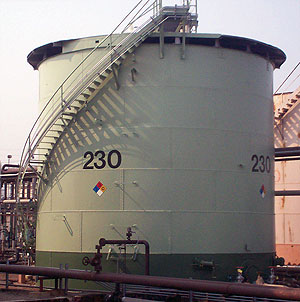Polysiloxane Coatings
P olysiloxane coatings are industrial protective and maintenance coatings that used in services characterized by abrasion, chemicals, extreme UV and high temperatures. The term polysiloxane refers to a polymer with a silicon-oxygen backbone. The silicon-oxygen backbone is much more resistant to the effects of UV radiation than the carbon-carbon backbone of organic polymers. Polysiloxanes have excellent aesthetic weathering attributes in terms of gloss retention and chalk resistance properties. They exhibit excellent abrasion and corrosion resistance, good chemical resistance, good anti-graffiti properties, resilience to dirt pickup and are formulated with low VOC‘s. Advances in polysiloxane chemistry have resulted in the development of three major categories of this type of coating:
olysiloxane coatings are industrial protective and maintenance coatings that used in services characterized by abrasion, chemicals, extreme UV and high temperatures. The term polysiloxane refers to a polymer with a silicon-oxygen backbone. The silicon-oxygen backbone is much more resistant to the effects of UV radiation than the carbon-carbon backbone of organic polymers. Polysiloxanes have excellent aesthetic weathering attributes in terms of gloss retention and chalk resistance properties. They exhibit excellent abrasion and corrosion resistance, good chemical resistance, good anti-graffiti properties, resilience to dirt pickup and are formulated with low VOC‘s. Advances in polysiloxane chemistry have resulted in the development of three major categories of this type of coating:
Inorganic Polysiloxanes: Typical inorganic polysiloxanes cure by hydrolytic polycondensation. Formulated with the proper selection of additives and pigments, coatings can resist temperatures of approximately 1,400°F (760°C). Variation of pigment creates coatings with excellent solvent resistance.
Epoxy-Polysiloxane Hybrids: Formulation with aliphatic epoxy resins, silicone intermediates, oxysilanes, and aminosilanes creates weather and corrosion-resistant hybrids. These coatings cure by both hydrolytic polycondensation and more conventional epoxy-amine mechanisms, resulting in what are known as interpenetrating polymer networks. The resulting formulations provide improved resistance to weathering over conventional epoxy coatings.
Acrylic-Polysiloxane Hybrids: By combining acrylic and siloxane resins, a low VOC, highly weatherable topcoat is produced. These systems can be produced as one- or two-component systems.
New chemical variants in polysiloxane coating chemistry are continuing to be developed at a rapid rate. Each manufacturer of polysiloxane coatings makes a compatible primer and intermediate/tie coat.
PolySiloxane Coatings are used on structural steel, steel tanks, barges, refineries, petrochemical plants, power plants, railcars, pulp & paper mills, masonry surfaces and others as recommended.